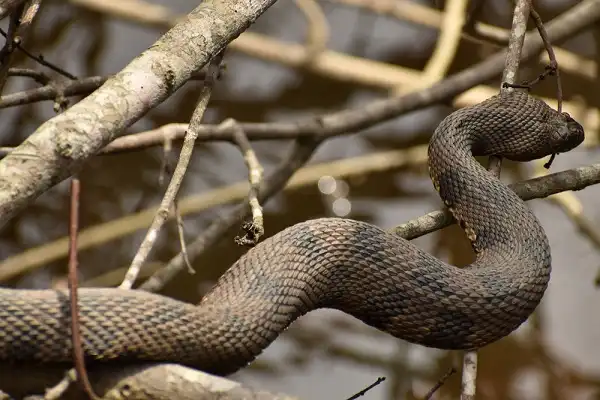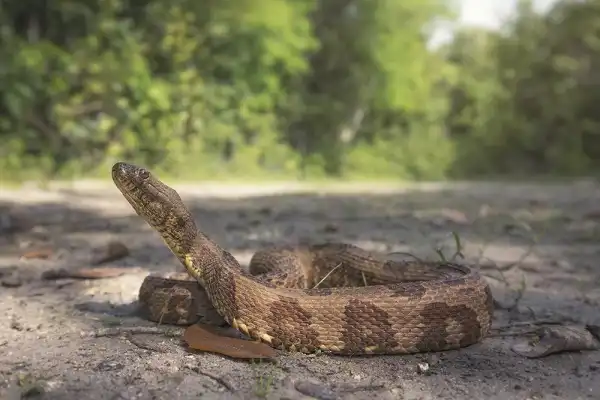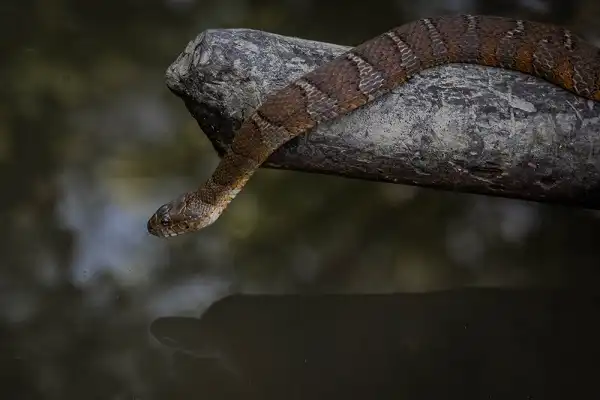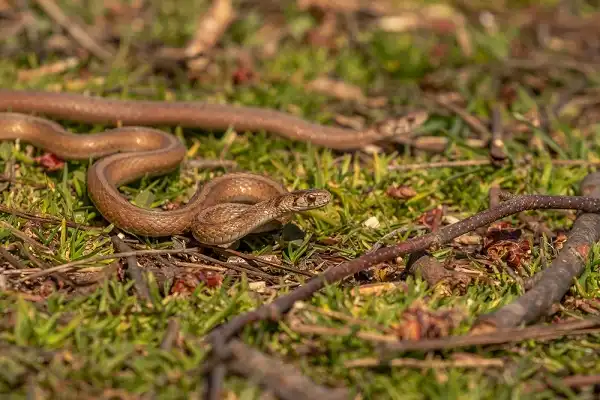The brown water snake, or Nerodia taxispilota, is a species of non-venomous snake native to the southeastern United States. As their name implies, these reptiles live in bodies of freshwater such as swamps and streams where they can be found hunting for prey like frogs and fish. While typically not aggressive towards humans, this type of snake does have strong defensive behaviors that make it important to remember the basics when encountering one -particularly if you plan on handling them! In this blog post, we’ll delve into all aspects of the molting habits and habitat preferences common to these fascinating aquatic creatures so you can enjoy learning more about them while remaining safe.

Brown Water Snake Description
The brown water snake is a fascinating species of non-venomous snake that is mainly found in the southeastern parts of the United States. As the name suggests, brown water snakes prefer freshwater bodies such as swamps, marshes, streams, and lakes, where they can thrive and hunt for their prey. These snakes are excellent swimmers and can even stay submerged for extended periods. They are also known to climb trees and vegetation along water bodies. One of the unique features of brown water snakes is their behavior during molting. Like other reptiles, brown water snakes shed their skin periodically as they grow. During the molting process, the snakes’ eyes become cloudy, and they may become agitated and defensive. It is crucial to respect the snake’s space and avoid disturbing them during this period, as it can become more aggressive and strike if threatened.
Brown Water Snake Habitat
The brown water snake is predominantly found in freshwater habitats such as swamps, marshes, and streams of the southeastern United States. These snakes are highly adaptable and can thrive in a range of aquatic environments from slow-moving water to fast-flowing rivers. They can even be found in artificial bodies of water such as canals, ponds, and reservoirs. In addition to their hunting habits, brown water snakes also rely on their environment for thermoregulation. They are ectothermic, which means that they need to absorb heat from their surroundings to regulate their body temperature. During cooler periods, they will bask on rocks, logs, and vegetation near water bodies to absorb warmth from the sun. This behavior is essential for maintaining their metabolic function, and they will even seek out sunny spots on overcast days. Despite their adaptability, brown water snakes are sensitive to habitat degradation, pollution, and habitat loss. Their dependence on freshwater ecosystems makes them vulnerable to water pollution from fertilizers and pesticides, as well as habitat destruction from development, urbanization, and damming. Conserving and restoring their habitat is crucial for their survival and for maintaining the health of their aquatic ecosystems.
Brown Water Snake Diet
The brown water snake is an opportunistic predator and feeds on a broad range of prey. Their diet includes various aquatic animals such as fish, tadpoles, frogs, crayfish, insects, and snails. Being ambush predators, they wait patiently for their prey to come closer before making their move. Their hunting techniques are highly efficient, and they can overpower their prey with ease. Fish constitute a significant portion of the brown water snake’s diet. They are known to feed on a variety of species, ranging from small minnows to larger catfish and bass. Their preference for certain fish species may depend on their size and availability in their habitat. The brown water snake’s hunting method includes stalking and attacking its prey quickly, disabling it with a bite, and then swallowing the prey whole. Apart from fish, brown water snakes also feed on other aquatic animals such as tadpoles, frogs, and crayfish. These animals are a valuable source of nutrition and an essential component of the snake’s diet. They hunt tadpoles and frogs by ambushing them as they swim by, while crayfish are caught using their powerful jaws and teeth.

Brown Water Snake Size
Brown water snakes are known for their modest size, with the majority of them measuring between 2 and 4 feet in length. However, some individuals can reach up to 5 feet in length, making them one of the larger species of water snakes in North America. Their body shape is cylindrical, with a thick neck that gradually tapers to a pointed tail. Like other water snakes, they have keeled scales that allow them to navigate through the water with ease. The scales on their belly are often a lighter color than those on their back, providing them with effective camouflage from predators and prey alike. Males are slightly larger than females, with a more substantial head and a longer tail. The average weight of an adult brown water snake is between 1-2 pounds. Juveniles are generally darker in color than adults, and their heads are more pointed, making them appear more aggressive than their mature counterparts.
Brown Water Snake Lifespan
The brown water snake’s lifespan is typically around 10 years in the wild. However, they have been known to live up to 20 years in captivity. Like all species, their lifespan is impacted by various factors, such as the availability of food, predation, and genetic makeup. Environmental factors such as temperature and water quality can also affect their lifespan. They are ectothermic, which means they rely on external sources of heat to regulate their body temperature. Therefore, changes in temperature and water quality can cause stress and negatively impact their health. Brown water snakes grow at a slower rate than other water snake species, reaching maturity at around 2-3 years of age. During the breeding season, which occurs from March to May, males will search for females and engage in courtship displays. Females will give birth to live young, with litters ranging in size from 10 to 30 offspring.
Brown Water Snake Behavior
Brown water snakes are fascinating species that exhibit a unique set of behaviors and adaptations that allow them to thrive in freshwater ecosystems. They are semi-aquatic creatures that spend much of their time in or around bodies of water, such as rivers, swamps, and ponds. Another notable adaptation of brown water snakes is their ability to climb trees. They are agile climbers and can be found in tree branches near the water’s edge. This behavior is thought to be related to their hunting habits, as they may climb trees to look for prey or escape predators. During the breeding season, male brown water snakes engage in courtship displays to attract females. The displays may include head bobbing, body undulation, and even vocalization. Once the female has been courted and mating has occurred, she will give birth to live young.

Brown Water Snake Speed
Brown water snakes are relatively slow-moving creatures that rely on stealth, rather than speed, to capture their prey. They are considered an ambush predator and may wait for hours for the perfect opportunity to strike. That being said, they can move quickly when the situation calls for it. In water, brown water snakes use a combination of swimming and paddling movements to propel themselves forward. Their strong tails help them swim at speeds of up to 3 or 4 miles per hour (mph). On land, they move much slower and typically travel at around 1 mph. The age and size of an individual snake can also affect its speed. Young juvenile snakes may be quicker and more agile due to their small size, while older adults tend to move more slowly. Overall, brown water snakes are not considered fast animals and rely on other adaptations, such as their excellent vision, hearing, and sense of smell to find and capture prey. Their ability to climb trees also gives them an advantage when it comes to hunting in the wild.
Brown Water Snake Hunting
Brown water snakes are known for their exceptional hunting prowess, which is achieved through a combination of patience, stealth, and precision. While they may move slowly and deliberately, their highly developed sense of smell allows them to locate prey with incredible accuracy. When hunting in the water, brown water snakes will wait in a motionless position for extended periods, waiting for their prey to swim within range. They may also slowly stalk their prey, using their highly sensitive tongue to track their movements. Once in range, these snakes will strike with lightning-fast speed, overpowering their prey with a quick bite. On land, brown water snakes are equally adept at hunting. They will typically lie in wait under cover, such as logs or vegetation, before striking out at passing prey. Their high level of camouflage allows them to blend in seamlessly with their surroundings, making them almost invisible to unsuspecting prey. While they are primarily ambush predators, brown water snakes are not averse to actively pursuing their prey. When hunting in the water, they will sometimes actively chase after prey, using their streamlined bodies to move quickly through the water. This method is particularly effective when pursuing small fish or other fast-moving creatures.
Brown Water Snake Predators
Brown water snakes are preyed upon by a variety of larger animals, including birds of prey, raccoons, and large fish. In addition, they are sometimes hunted by humans for their skins. This has led to population declines in some areas due to overharvesting. Brown water snakes are an important part of freshwater ecosystems and a fascinating species to observe and study. While relatively slow-moving creatures, these predators rely on stealth and skill to capture their prey. With human impact threatening their survival, protecting and conserving their habitats is essential for ensuring the long-term survival of this species. By understanding more about these creatures and implementing conservation strategies, we can help protect them from further decline. This is a great way to ensure the future of these incredible animals and the freshwater ecosystems they inhabit.

Conclusion
Brown water snakes are one of nature’s most formidable predators, relying on patience and precision to capture their prey. Despite their relatively slow movements, these creatures remain successful hunters due to their highly developed sense of smell and exceptional camouflage abilities. Unfortunately, the brown water snake is facing numerous threats to its survival, including habitat destruction, pollution, and over-harvesting in the pet trade. Protecting and conserving these habitats is essential for ensuring the long-term survival of this fascinating species. By doing so, we can help to preserve these remarkable animals in the future.
Frequently Asked Question

